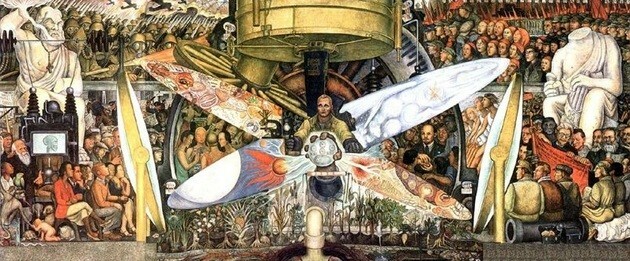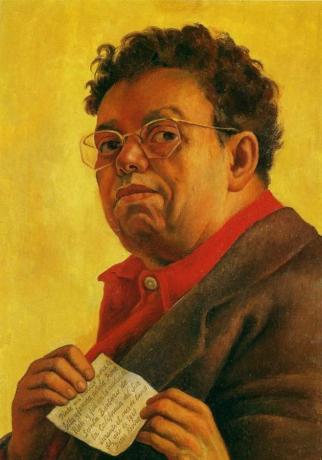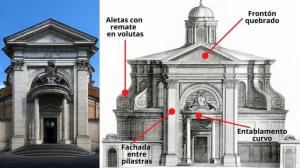Diego Rivera: 5 fundamental murals of the Mexican genius
Diego Rivera (1886-1957) was one of the most famous Mexican painters, remembered especially for the brilliant career he developed in the movement of the mexican muralism, along with José Clemente Orozco and David Alfaro Siqueiros.
However, although many know his name, not all know the fundamental works of him. In this article we will know the most emblematic works of him and the reasons for his importance.
The creation

The mural called The creation It was prepared in 1922 by order of the then Secretary of Education of Mexico, José Vasconcelos. It is emblematic because it is the first mural developed by the artist. It is inspired by aesthetic elements taken from his experiences on a trip to Tehuantepec.
The center of the composition is the starting point, from where a man emerges from an original "cell" with his arms outstretched. The blue semicircle acts as a symbol of the energy or creative principle that radiates to all ends of the painting.
On each side are two scenes. The one on the left is an allegory of the music, which wears sheepskin and a flute. Along with this figure, he is also accompanied by the allegories of the singing, with a red dress; the comedy, who wears braids, and the dance, who is standing with raised arms. In addition, the theological virtues appear, the hope, the charity and the faith.
In the right panel, the allegory of the fable; who wears blue and gold; the tradition, who wears a crimson dress; the erotic poetry and the tragedy, the latter with her face covered by a mask; next to these allegories appear the personifications of the cardinal virtues: the prudence; the Justice, the continence and the strength. At the feet of each group, the man (right) and the woman (left) are seated and naked.
Riveriana Chapel Murals

Total area: 700 mts².
Diego Rivera was also in charge of the decoration of different spaces of the Autonomous University of Chapingo, a group of which he particularly highlighted the decoration of the so-called Riveriana Chapel, in a clear allusion to the Sistine Chapel of Miguel Angel.
In this play. Rivera applied several of the principles studied during his stay in Italy, where he had the opportunity to learn about the work of the great masters. Inside the chapel, Rivera alludes to the duality of nature and science.
Thus, in this work he performs what connoisseurs of the work call a song to the cycles of life. The right side panels are a celebration of nature, representing a feminine principle associated with fertility. Meanwhile, the left panels evoke historical strength, work, struggles and revolutions, symbolically associated with the masculine.
In the center, there is a pregnant woman lying on her right side. This panel is called The fertile land. In the woman's pregnancy, Rivera symbolizes the only moment in human life where the feminine and the masculine coexist in a single body. The force of nature and the action of history also converge in it.
The pregnant woman is surrounded by the four elements, and at the same time, elements of science and technology such as electricity-generating dams and others appear. It was his then wife, Guadalupe Marín, who served as the painter's model.
Epic of the Mexican people

This work is one of the most monumental pieces by Diego Rivera. It is an immense group of murals that occupies all the walls of the staircase of the National Palace of Mexico. Its execution began in 1929 and ended in 1935. It was also commissioned by José Vasconcelos.
The section on the right represents the pre-Hispanic history of Mexico; the central section represents the process of conquest and colonization, while the third section represents the formulation of the Marxist ideology at the beginning of the 20th century.
See also 5 keys to understanding the importance of Mexican muralism.
The controlling man of the universe

This mural, also known as The man at the crossroads, has been one of the most controversial murals by Diego Rivera. The reason for this is that, in the first place, it was created and executed for the Rockefeller Center, in the United States, a country where Rivera enjoyed some recognition.
However, Rivera included the face of Lenin in the mural, which was observed as disrespect and a challenge, before which they ordered the work to be destroyed. Years later, in 1934, Rivera would repeat the project at the Palacio de Bellas Artes in Mexico.
It is a figurative development in three sections. In the center, a worker controls the universe through the machine and production. On the left is capitalist society and its army. On the right, the workers of the Red Square, the Russian army and the main ideologues or leaders of the Soviet revolution: Karl Marx, Friederich Engels, Vladimir Lenin and Leon Trotsky.
For Rivera, the universe is represented there as he conceives it: ideology, science, revolution, all elements in conflict through the class struggle.
See also Analysis of the mural The controlling man of the universe.
Dream of an afternoon in the Alameda Central

This mural by Diego Rivera responded to an initiative of the Mexican architect Carlos Obregón Santacilia. It is currently located in the Diego Rivera Museum, although it was originally in the Hotel El Prado.
In this mural, Diego Rivera portrays himself as a child while strolling through the Alameda Central in Mexico City. Throughout his journey, he is accompanied by more than a hundred fundamental characters in Mexican history.
The composition is dominated in the center by a Catrina or Calavera Garbancera, a visual creation of the famous artist and cartoonist José Guadalupe Posada, who appears on the right. On the left, next to La Catrina, appears Frida Kahlo, Rivera's wife at that time.
While the left side evokes the characters of the historical domination movements that Mexico has faced (conquest, colonization, independence, imperialism and interventionism), the right side evokes the leaders of popular struggles and revolutions.
You may also like:
- Frida Kahlo: biography, paintings, style and phrases.
- La Catrina by José Guadalupe Posada.
About Diego Rivera

Diego Rivera was born in Mexico in 1886. He studied painting from 1896 with the landscaper José María Velasco. In 1907 he received financial support from the State to study in Spain. He travels to Paris in 1909, where he becomes engaged to the painter Angelina Beloff.
Unlike his colleagues Orozco and Siqueiros, Rivera was not directly involved with the Mexican Revolution, since he had broken out in 1910, after his departure for Europe. Their relationship will be, rather, ideological.
In 1921 he was invited to Mexico by the secretary of education José Vasconcelos. So in 1922 he painted the mural The creation. Along with David Alfaro Siqueiros and José Clemente Orozco, Diego Rivera was co-founder of the Sindicato de Revolutionary Painters, Sculptors and Graphic Artists, and develop the muralism program Mexican.
Rivera also devoted himself to the study of pre-Hispanic art, one of his sources of inspiration, and became an important collector.
He was married to Guadalupe Martín with whom he had two daughters, Lupe and Ruth. He then he married Frida Kahlo and, upon her death, Emma Hurtado. He was a member of the Communist Party of Mexico until his expulsion in 1929.
He did various works in the United States, one of which was the famous mural The controlling man of the universe, intended to be exhibited at Rockefeller Center. The mural was destroyed because it represented the face of Lenin. Rivera paints a new version of this mural upon returning to Mexico, as well as his famous work Dream of an afternoon in the Alameda Central (1948).
In 1950 he illustrated the poetry book General sing by Pablo Neruda. He also obtains the National Prize of Sciences and Arts of Mexico.
Finally, Rivera died in Mexico City in 1957.
Other important works by Diego Rivera
- Portrait of Portrait of Adolfo Best Maugard, 1913. Oil on canvas.
- Entrance to the mine, 1923. Cool.
- Flower Festival, 1925. Oil on canvas.
- Dance of Tehuantepec, 1928. Oil on canvas.
- Zapata, Agrarian Leader, 1931. Cool.
- The Making of a Fresco, Showing The Building of a City, 1931. Mural.
- Detroit Industry, 1933. Cool.
- The Flower Carrier, 1935. Tempera and oil on masonite.
- Para-American unit, 1940. Mural.
- Portrait of Natasha Zakólkowa Gelman, 1943. Oil on canvas.
- Nude with Gannets, 1944. Oil on masonite.



